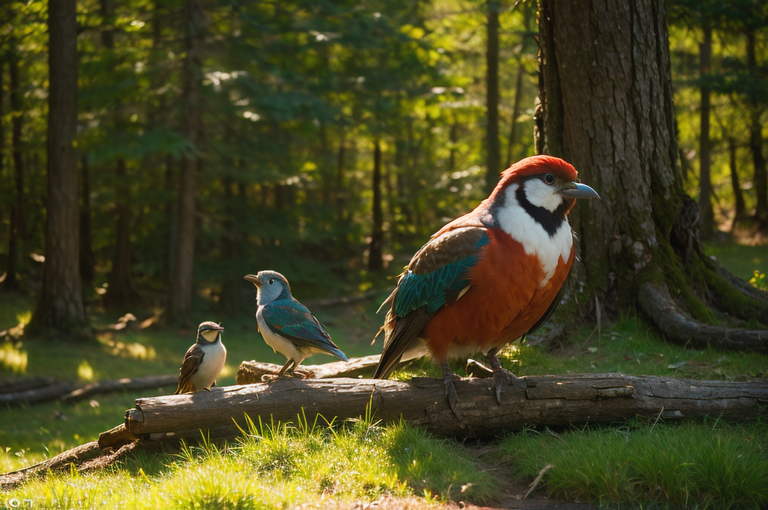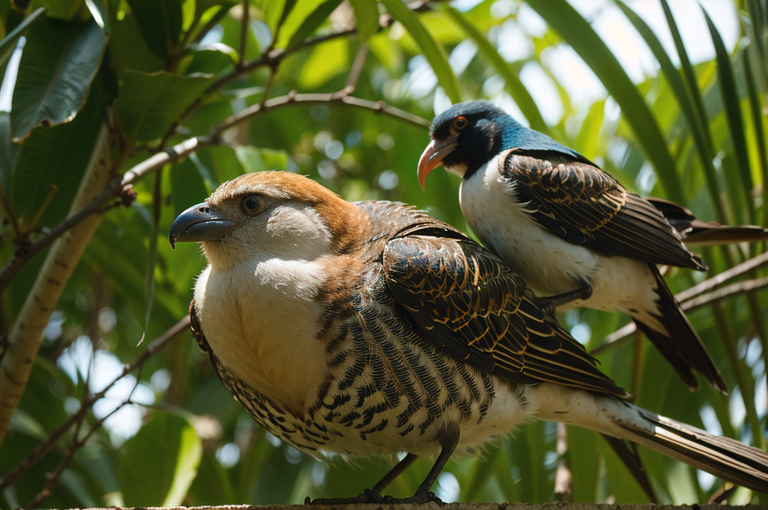Wild Parrots and Lovebirds: Thriving in Urban Environments Across the Globe

The article discusses wild parrots, the Rosy-Faced and Peach Faced Lovebirds, and Monk Parrots, detailing their characteristics, habitats, and their ability to form communities in urban areas globally.
The Fascinating World of Wild Parrots
I suppose we should begin at the wild bird tables of nature, where I so often find myself sitting with my notebook and binoculars. There’s something eternally captivating about observing wild parrots in their natural habitats. And in doing so, one cannot help but acknowledge these feathered wonders’ inherent social prowess and intellectual capacities.
Delving into the World of Wild Parrots
Wild parrots, blessed with an intelligence that rivals that of some mammals, are remarkably social creatures. They have a fascinating predisposition towards communal living, invariably favoring the safety and companionship of a flock over solitary life. It’s a trait that contributes significantly to their higher survival rates a dazzling array of colours, feathers, and cackling calls often seen whirling through tree canopies as a united group.
Challenges Encountered by Wild Parrots in Human Care
Unfortunately, complications arise when those of us with an admittedly innocent case of avian admiration, attempt to house these wild creatures. Our simply human perspective can often leave us blind to the intricate and complex needs of our wild parrot friends. These oversights, often born from misunderstanding or lack of knowledge, can inadvertently result in harm to these delicate beings.
The Remarkable Survivability and Adaptability of Wild Parrots
However, within the paradox of vulnerability and adaptability, the survivability of wild parrots shines through like a vibrant feathered phoenix. Wild parrots are not mere beauties, they are fighters, survivors they will grasp the threads of resilience and weave them into an astonishing tapestry of survival.
Through my writings, conversations, sightings, and wild bird tables anecdotes, I aim to share and inspire a newfound respect and understanding for these creatures. Because it isn’t just about how we intrigue ourselves with their colorful plumes and chatter, it’s about how we allow them to flourish in their natural grandeur. So, join me, won’t you? As we delve further into the captivating world of wild parrots, and everything else that takes wing under the sun.

Rosy-Faced Lovebirds: A Glimpse into the Wilderness
The explorations of a wild bird enthusiast often teem with delightful surprises, and one such unexpected treasure is the rosy faced lovebird. Its unique features always leave me in awe. The free flowing finesse of their flight, the perfect blend of green and blue in their feathers, and, of course, their characteristically rosy faces are like an artist’s masterstroke on a canvas of enigma. Yet, their charming beauty isn’t confined to their looks. There’s a ruggedness about these lovebirds that echoes the untamed call of the wild, much like the wild birds hovering freely in the grandeur of nature itself.
Recognizing the Rosy-Faced Lovebirds
I’ve always found the rosy faced lovebirds to be a fantastic blend of color and character. Their bodies, painted in vibrant green, give way to slices of blue at the base of their tail feathers and wingtips. They are like flying monets with plumes dipped in a pot of rosy hues. There’s a striking symmetry to their appearance, with both male and female lovebirds showcasing a similar plumage.
A Journey into their Native Habitats
Inhabiting the dry vistas of southwestern Africa, these birds are survivors, acclimatized to some of the most challenging habitats. The resilience and striking vibrancy of these birds make them a spectacle that is indeed spell binding.
The Global Travels
Over time, these parrots have spread their wings, soaring from their native habitats to far off lands. Including the enchanting Hawaii Birding Trails. Far from their native home, yet they thrive, proving their tenacity and adaptability just like the wild birds I have always been fascinated with.
As I continue my journey through the avian kingdom, the rosy faced lovebirds stand as testimony to the unexpected exuberance and adaptability of life, mirroring the magic that the world of wild birds holds for us all.

Different Types of Wild Parrots: Peach Faced Lovebirds
As if woken up by an aria of peach faced lovebirds—those love birds wild and beautiful—I find myself contemplating the enchanting world of avian diversity anew. Today, I wish to cast a spotlight on one such remarkable species that’s always been a curiosity for me—a wild parrot known the world over as the Peach Faced Lovebird.
Brief Overview of Peach Faced Lovebirds
Peach Faced Lovebirds are inhabitants of grasslands and dry woodlands, they’ve made our hearts their abode. These verdant creatures, splashed with vibrant hues of blue and peach, are natives of South Western Africa. Their vivid color and charming behavior have made them popular among bird lovers. Despite their delicate demeanor, these creatures are quite hardy and can adapt to a variety of environmental conditions. They’re unique parrots because of their strong bonding habits. Once paired, they remain together for life—you could say they are truly the epitome of love birds wild.
Recognizing Peach Faced Lovebirds
These vibrant parrots can be easily recognized. Their upward curving, sharp beaks and vibrant, peach colored faces are distinct markers. The animals have a green body with segments of blue on their rumps and tails. Aside from their physical characteristics, their social behaviors are another hint. Watch them during feeding time—these little parrots often feed their partners, like a silent song of love shared in the wilderness over a morsel of wild fruit.
Together, we explored the enchanting sphere of Peach Faced Lovebirds, a testament to the wild, enthralling, and often unpredictable, realm of birds that never fails to captivate my heart.

Wild Parrots Adapting to Urban Areas
As the earth begins to awaken at dawn, I find myself opening my windows, curious to observe the unusual symphony of parrot chatter right from cities like Boston and Chicago. It’s a fascinating juxtaposition, the vibrant splash of tropical feathers against the steely monochrome of urban structures.
Global Phenomenon of Parrots in Urban Environments
Believe it or not, parrot communities have taken residence in various urban landscapes across the globe. From the sun washed coasts of San Francisco to the bustling cityscape of Tokyo, they’ve found their place amidst the concrete jungles, adapting, thriving, echoing their squawks as if to claim their territory.
Presence of Wild Parrots in Mid-Atlantic and Cold Cities
Imagine my delight, as an ornithologist, witnessing a flock of wild parrots thriving in the heart of winter bitten cities like Boston and Chicago. Quite impressive, wouldn’t you agree? It makes me wonder how birders manage their supply of wild bird unlimited bird feeders in such climates!
Explanation for Parrots’ Adaptability in Urban Settings
The key to understanding this adaptability of parrots lies in their grit and resilience. Forced out of their native tropical habitats due to deforestation and traded as exotic pets, many have escaped or been released into unexpected environments. Yet, they’ve managed to survive and even flourish, flexing their adaptive muscles in these new urban homes.
The beauty of this phenomenon? It’s a testament to the tenacity and vibrancy of life of these feathered wonders resiliently carving out a space for themselves in a world that is far from the jungles they once knew.
Showcase of Adaptability: Monk Parrots
As dawn’s first light cascades through my window, stirring me from my slumber, I think of the Monk Parrots. Truly a testament to adaptability among our friends, the wild birds. By nature, these creatures are tropical parrots, a far cry from the suburban landscapes they now call home.
General Characteristics of Monk Parrots
Cloaked in vibrant green plumage, they are a sight to behold. Their acrobatic antics around wild bird tables can brighten any dull morning. Their lively chatter reminds me of carefree love birds in the wild. Their vivid feathers, stark against city backdrops, are a daily reminder of nature’s uncanny knack for survival in the most unlikely places.
Monk Parrots’ Great Adaptability
One could easily mistake these adaptable beings for denizens of lush rainforests, for indeed, this is where they originate. Yet, their true strength lies in their versatility. You’d be surprised to find how comfortably they’ve adjusted to the brick and steel wilderness of our urban world. You might spot them around wild bird unlimited bird feeders, a sight that reflects their skill for adaptation, their ability to carve a niche for themselves in this cacophony we call civilization.
Geographical Spread of Monk Parrots
These resilient creatures have expanded their locales beyond the sting of tropical sun and salsa of raindrops on banana leaves. They have replaced the echoes of the rainforest with the murmur of mid Atlantic cities and the icy whispers of Boston and Chicago. Truly, a stunning achievement in the world of wild birds, showing us the vitality and adaptability of nature in its purest form, reminding us that every ostensible end is but a new beginning. In their story, I am reminded of the enchanting, ceaseless dance of existence a dance, I am privileged to translate into words for you all. Another day begins, greeted by the green hued specters growing bolder in the face of relentless change.


